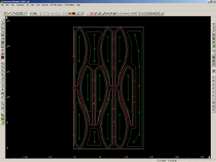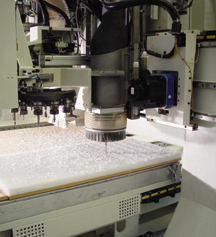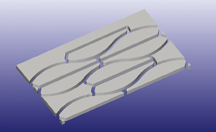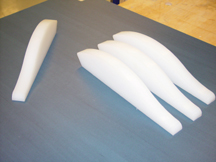|
Improving Efficiency In CNC Routing
If you are considering adding another panel saw or CNC
router to your operation, or if you are a first time CNC
buyer, you should consider the benefits of using Nested
Based Manufacturing (NBM). Nested Based Manufacturing or
“nesting” is a manufacturing method that many plastic distributors
and fabricators can adopt in order to improve the
efficiency of their new or existing CNC routing operation.
Simply put, Nested Based Manufacturing is a
process that utilizes a CNC Router to produce finished
parts ready for gluing, assembly or shipment to the customer
without presawing or secondary finishing operation.
It begins with part drawings (existing or newly drawn)
being optimized by software within the dimensions of a
defined sheet
size. The parts
are then machined
on the
CNC router in
the exact pattern
defined by
the software or
by the designer
out of a single
sheet. The
completed run
will look something
like a
puzzle. Parts
can be arranged to provide the highest possible material
yield and minimize waste. In addition to these benefits,
NBM can provide faster processing and fewer mistakes
due to reduced set up time and no required precutting.
While some jobs are better produced by cutting blanks
to size on a saw and then machining, many distributors
and fabricators are currently producing parts that could
be “nested” more efficiently. Because of recent advances
in CNC router technology, some parts traditionally “CNC
milled” or “machined from blanks” can be processed more
efficiently using NBM. Nested Based Manufacturing is an
alternative way of approaching fabrication and can be
used in conjunction with traditional CNC methods to maximize
efficiency and productivity.
Some examples of how NBM can improve efficiencies of
existing jobs are single part runs and multiple part runs to
include product components. In single part runs, some parts
are traditionally produced by first cutting blanks to size on
a saw and then machining those blanks on a CNC Router or
Mill. Utilizing NBM, the part would be optimized over a full
4’ x 8’ (or your standard size) sheet and machined in one
operation. This saves dual set up time, reduces material
handling, maximizes yield from the material and ensures
repeatable tolerances. With multiple part runs, several different
part shapes or multiple components of products such
as displays can be optimized using NBM. Different parts can
be combined to take advantage of the optimized material
yield and streamline several operations into one.
Another example of a good NBM application
would be the routing of 5 fi” diameter disks.

Conventional cutting and machining from blanks
would yield 128 parts from a 48” x 96” sheet as
compared to 135 pieces from the same sheet size
when NBM is utilized. In this case, the yield is
5.5% greater with less material handling and
labor content.
Machine Requirements
The necessary requirements for Nested Based
Manufacturing are a CNC router and software
with nesting capability. Depending on your needs,
single or multiple head machines can be used for
the nesting process. Important router features for
nesting include table size and design, vacuum
capability, chip evacuation, tool changing and
positioning speeds. For best results, the table size
should be large enough to accommodate your
standard size sheet material. A minimum table
bed of 4’ x 8’ or 5’ x 10’ is common.

The table
design should provide for enhanced vacuum hold
down with the flexibility to use many different
types of fixtures. State-of-the-art table systems
combine a high tech aluminum grid table with
large vacuum tubes evenly distributed below the
table to achieve strong, even hold down. Larger
parts can be held down during machining using a
blank, bleed-through spoil board; however the
nesting of smaller parts may require a specialized
spoil board or fixture to successfully hold down
the pieces. Because parts are machined in close
proximity, chip evacuation is crucial to obtain best results. An
excess of chips around the router bit can result in re-melting and
attaching to the tool, leading to a poor finish. The best chip evacuation
can be obtained by combining an ample dust/chip collector
with a CNC router that has an effective chip collection design. CNC
controlled dust hoods around the router bit with 360º pickup capability
are found on well designed chip collection systems. The ability
to change tools rapidly provides some of the efficiency benefit
when using NBM. A quick or rapid style changer with a minimum of
eight positions should be considered. A CNC router equipped with
this type of rapid tool-changer can move quickly from one operation
to the next with a minimum of lost time. Positioning speeds are an
important consideration for quick cycle times. Combined with a tool change, high speed movement from the end of one operation
to the beginning of the next can save as much as 10-
15% off normal cycle times.
Software
While many current software packages available with
 CNC routers have a “nesting function” included in the
package, not all software is equal. In addition to important
features used for typical routing applications, key aspects
of software used
for NBM include
full 3-D simulation
and tool
path editing capability.
3-D simulation
allows a
user to review
the machining of
the part as programmed
allowing
an opportunity
to correct errors
or make
changes before any plastic is cut. This feature reduces programming
time and prevents unneeded waste of material.
When nesting small, hard to hold parts, it is important to
have advanced tool path editing capability for full manipulation
of lead in/lead out and tool insertion point. These
tools allow the programmer to quickly adjust router bit
point of entry and angle of attack in order to reduce pressure
on parts when routing. Using these advanced tools
can make the difference of being able to effectively hold
small parts down when machining.
CNC routers have a “nesting function” included in the
package, not all software is equal. In addition to important
features used for typical routing applications, key aspects
of software used
for NBM include
full 3-D simulation
and tool
path editing capability.
3-D simulation
allows a
user to review
the machining of
the part as programmed
allowing
an opportunity
to correct errors
or make
changes before any plastic is cut. This feature reduces programming
time and prevents unneeded waste of material.
When nesting small, hard to hold parts, it is important to
have advanced tool path editing capability for full manipulation
of lead in/lead out and tool insertion point. These
tools allow the programmer to quickly adjust router bit
point of entry and angle of attack in order to reduce pressure
on parts when routing. Using these advanced tools
can make the difference of being able to effectively hold
small parts down when machining.

Nest Based Manufacturing can provide efficiencies over
traditional routing methods when material handling costs,
material yield and
part repeatability
are important
considerations. If
you are considering
the nested
based approach,
have your staff
conduct an internal
study to
determine the
benefit of such a
process. Some
CNC Router manufacturers
can also provide you with “time studies” that
can measure the savings of moving jobs to NBM.
Written by Phil Bryant, Business Manager, Plastics for SCM
Group USA, manufacturers of CNC Routers and Computerized
Panel Saws.
For more information, contact SCM Group
USA, 2475 Satellite Blvd., Duluth, GA 30096, 800-292-
1850, 770-813-8818, Fax: 770-813-8819, E-Mail: info@
scmplastics.com, Web: www.scmplastics.com.
|